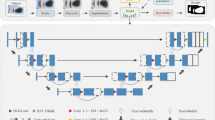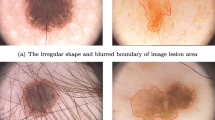Abstract
Skin melanoma is one of the most malignant tumors. In recent years, its incidence rate and mortality showed a high growth trend. Early detection and segmentation of skin lesions are vital in timely diagnosis and treatment. As the low contrast of lesion regions and high similarity in terms of appearance, skin lesion segmentation still remains a challenging work. Most of the segmentation methods use single-scale feature fusion, leading to the blur effect on the boundary. In this paper, we propose a new segmentation framework named Intensive Atrous Spatial Transformer Network (IASTrans-Net), which is based on a core module Intensive Atrous Spatial Pyramid Pooling (IASPP). The introduced IASPP can obtain valid features by using multi-scale feature fusion and channel attention. On the one hand, we employ atrous convolution with different dilation rates for multi-scale information extraction, ensuring that the effective information of each channel is obtained. On the other hand, channel attention is used to screen features, which can enable the network to effectively identify targets without increasing the training complexity. The experimental results show that the proposed IASTrans-Net has achieved good results in ISIC2017 and ISIC2018 datasets, surpassing most of the current mainstream methods.
Access this chapter
Tax calculation will be finalised at checkout
Purchases are for personal use only
Similar content being viewed by others
References
Al-Masni, M.A., Al-Antari, M.A., Choi, M.T., Han, S.M., Kim, T.S.: Skin lesion segmentation in dermoscopy images via deep full resolution convolutional networks. Comput. Meth. Prog. Biomed. 162, 221–231 (2018)
Asadi-Aghbolaghi, M., Azad, R., Fathy, M., Escalera, S.: Multi-level context gating of embedded collective knowledge for medical image segmentation. CoRR (2020)
Cao, H., et al.: Swin-unet: Unet-like pure transformer for medical image segmentation. CoRR (2021)
Celebi, M.E., et al.: A methodological approach to the classification of dermoscopy images. Computer. Med. Imaging Graph. 31(6), 362–373 (2007)
Chen, J., et al.: Transunet: Transformers make strong encoders for medical image segmentation. CoRR (2021)
Chen, L.C., Papandreou, G., Kokkinos, I., Murphy, K., Yuille, A.L.: Deeplab: Semantic image segmentation with deep convolutional nets, atrous convolution, and fully connected CRFS. IEEE Trans. Pattern Anal. Mach. Intell. (2014)
Codella, N.C., et al.: Skin lesion analysis toward melanoma detection: a challenge at the 2017 international symposium on biomedical imaging (ISBI), hosted by the international skin imaging collaboration (ISIC). In: 2018 IEEE 15th International Symposium on Biomedical Imaging, pp. 168–172 (2018)
Day, G.R., Barbour, R.H.: Automated melanoma diagnosis: where are we at? Skin Res. Technol. 6(1), 1–5 (2000)
Garnavi, R., Aldeen, M., Celebi, M.E., Bhuiyan, A., Dolianitis, C., Varigos, G.: Automatic segmentation of dermoscopy images using histogram thresholding on optimal color channels. Int. J. Med. Med. Sci. 1(2), 126–134 (2010)
Hardie, R.C., Ali, R., De Silva, M.S., Kebede, T.M.: Skin lesion segmentation and classification for ISIC 2018 using traditional classifiers with hand-crafted features. CoRR (2018)
He, K., Gkioxari, G., Dollár, P., Girshick, R.: Mask R-CNN. In: Proceedings of the IEEE International Conference on Computer Vision, pp. 2961–2969 (2017)
Jha, D., Riegler, M.A., Johansen, D., Halvorsen, P., Johansen, H.D.: Doubleu-net: a deep convolutional neural network for medical image segmentation. In: 2020 IEEE 33rd International Symposium on Computer-based Medical Systems (CBMS), pp. 558–564 (2020)
Kolesnikov, A., et al.: An image is worth 16 \(\times \) 16 words: Transformers for image recognition at scale (2021)
Liu, Z., Zerubia, J.: Skin image illumination modeling and chromophore identification for melanoma diagnosis. Phys. Med. Biol. 60(9), 3415 (2015)
Long, J., Shelhamer, E., Darrell, T.: Fully convolutional networks for semantic segmentation. In: Proceedings of the IEEE Conference on Computer Vision and Pattern Recognition, pp. 3431–3440 (2015)
Ronneberger, O., Fischer, P., Brox, T.: U-net: convolutional networks for biomedical image segmentation. In: International Conference on Medical image Computing and Computer-Assisted Intervention, pp. 234–241 (2015)
Silveria, M., et al.: Comparison of segmentation methods for melanoma diagnosis in dermoscopy images. IEEE J. Select. Top. Sign. Process. 3(1), 35–45 (2009)
Singh, V.K., et al.: FCA-Net: adversarial learning for skin lesion segmentation based on multi-scale features and factorized channel attention. IEEE Access 7, 130552–130565 (2019)
Singh, V.K., et al.: FCA-Net: adversarial learning for skin lesion segmentation based on multi-scale features and factorized channel attention. IEEE Access 7, 130552–130565 (2019)
Vesal, S., Ravikumar, N., Maier, A.K.: SkinNet: a deep learning framework for skin lesion segmentation. CoRR (2018)
Wang, H., Cao, P., Wang, J., Zaïane, O.R.: Uctransnet: rethinking the skip connections in u-net from a channel-wise perspective with transformer. CoRR (2021)
Wang, Z., Zou, N., Shen, D., Ji, S.: Non-local u-nets for biomedical image segmentation. In: Proceedings of the AAAI Conference on Artificial Intelligence, vol. 34, pp. 6315–6322 (2020)
Wong, A., Scharcanski, J., Fieguth, P.: Automatic skin lesion segmentation via iterative stochastic region merging. IEEE Trans. Inf. Technol. Biomed. 15(6), 929–936 (2011)
Zhao, H., Shi, J., Qi, X., Wang, X., Jia, J.: Pyramid scene parsing network. In: Proceedings of the IEEE Conference on Computer Vision and Pattern Recognition, pp. 2881–2890 (2017)
Zheng, S., et al.: Conditional random fields as recurrent neural networks. In: Proceedings of the IEEE International Conference on Computer Vision, pp. 1529–1537 (2015)
Acknowledgements
This work was supported in part by the Special Project of Central Government Guiding Local Science and Technology Development (Grant No. 2021JH6/10500140), Program for the Liaoning Distinguished Professor, Program for Innovative Research Team in University of Liaoning Province (Grant No. LT2020015), the Support Plan for Key Field Innovation Team of Dalian (Grant No. 2021RT06), the Science and Technology Innovation Fund of Dalian (Grant No. 2020JJ25CY001), the Support Plan for Leading Innovation Team of Dalian University (Grant No. XLJ202010), Program for the Liaoning Province Doctoral Research Starting Fund (Grant No. 2022-BS-336).
Author information
Authors and Affiliations
Corresponding authors
Editor information
Editors and Affiliations
Copyright information
© 2022 The Author(s), under exclusive license to Springer Nature Switzerland AG
About this paper
Cite this paper
Liu, X., Fan, W., Zhou, D. (2022). Skin Lesion Segmentation via Intensive Atrous Spatial Transformer. In: Wang, L., Segal, M., Chen, J., Qiu, T. (eds) Wireless Algorithms, Systems, and Applications. WASA 2022. Lecture Notes in Computer Science, vol 13471. Springer, Cham. https://doi.org/10.1007/978-3-031-19208-1_2
Download citation
DOI: https://doi.org/10.1007/978-3-031-19208-1_2
Published:
Publisher Name: Springer, Cham
Print ISBN: 978-3-031-19207-4
Online ISBN: 978-3-031-19208-1
eBook Packages: Computer ScienceComputer Science (R0)




